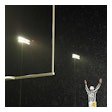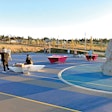Synthetic turf systems have evolved over the past quarter century, but buying the right field still requires plenty of decision-making.
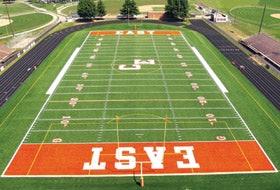
Synthetic turf systems have evolved greatly over the past 25 years, from crowned nylon carpets to infill systems composed of easily compacted angular sand and abrasive polypropylene fibers. Today's fields employ softer polyethylene yarns and infills of rounded sand and crumb rubber, rubber only, something else entirely or no infill at all.
The market is now crowded with system builders that want your business, and each can tweak a field's specifications to better fit your exact needs and desires. You just need to know what those needs and desires are. Here are six questions to consider once you've decided to make the switch to synthetic.
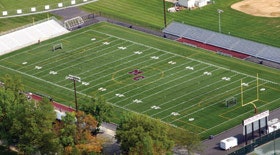
Also, soccer coaches and players may voice a preference in how the field is crowned, if at all. In reality, the superior permeability and subgrade drainage of infill systems require no crowning of the field whatsoever, which would be the natural preference of ball-roll sports like soccer and field hockey. But perfectly flat fields tend to appear slightly concave to the casual observer. To better simulate a grass field, without greatly impacting its playability for any one of a variety of sports, some system builders install fields with a barely perceptible half-percent grade from the center of the field to the sidelines or with a turtleback crown that tapers at the same rate toward the end lines.
Are permanent markings for more than one sport advisable? Many multipurpose fields feature a white football grid and yellow soccer boundaries as permanent components of the system, but additional colors for, say, field hockey and lacrosse (typically red and blue, respectively) can be specified. Any additional boundaries beyond that - five-sport fields, though uncommon, do indeed exist - result in a potentially confusing array of interwoven game lines.
There are obvious maintenance advantages to choosing permanent lines over semiannual paint applications, and manufacturers and installers have made it easy to think long-term. Five-yard lines now arrive from the factory as the tufted white edge on 15-foot-wide rolls of green turf. Sidelines can be permanently established by running such a roll the length of the field in perpendicular relation to the yard-line layout, and 6-foot-wide white sidelines, if so desired, also can be produced in the factory. That said, non-contiguous features such as hash marks, numerals and midfield or end zone logos and letters must be cut and glued in place by hand (at some additional installation cost) or painted (at some ongoing maintenance cost). The same is true of curvilinear game markings, such as a soccer field's center circle.
Game fields are rarely installed these days as blank slates of pure green, but practice fields are sometimes specified in such a way. To accommodate sports that aren't part of a field's regular programming, field builders can inlay permanent reference points within the turf, thus eliminating the need to measure off a given sport's boundary specifications on the occasion they need to be painted.
Turf companies should be able to provide renderings of what the finished field installation will look like, and some even provide software that allows buyers to "play" with any number of aesthetic options. Overall project cost begins to climb with each end zone letter specified, whether the letter is outlined or shadowed (or both), and whether it appears against a colored backdrop. These extras (which run roughly 5 to 10 cents per square foot) can add between $5,000 and $25,000 to a project, depending on its complexity, but are still a small percentage of the final price tag.
And just because most field specifications and aesthetics can be inlaid in turf, they aren't by any measure set in stone. If additional monies are secured after the initial purchase, an installer can come back to place, for example, a five-tone mascot on the 50-yard line or reword an entire end zone.

Only at the collegiate level might separate synthetic fields for specific sports be feasible. However, a high school can make room for field hockey on the football/soccer field by finding some middle ground in the infill system specifications. This may require a tighter matrix, with rows of tufted fibers spaced as close as 3/8 of an inch, and a face weight, measured in ounces of fiber per square yard, on the heavier side of the 30-to-60-ounce range. It may also mean specifying shorter fiber heights (say, 1½ inches as opposed to 2½ inches) or ensuring sufficient infill quantity and depth to expose less of each fiber blade - perhaps as little as 3/8 of an inch.
Some systems now incorporate two fiber heights into the same matrix. Available with a limited amount of infill or without any infill at all, this type of system features a dense layer of short, often squiggly nylon fibers surrounding and supporting longer, non-abrasive polyethylene blades. The goal is to simulate the look and cushioning of the natural thatch layer found on cool-season grass fields, while mitigating (or eliminating) excessive infill migration and "flyout." A final option, one free of infill, represents something of a throwback. Gaining traction particularly among soccer and baseball players, this type of turf system features a uniform nylon pile re-engineered to address the abrasiveness and colorfast issues of the original Astroturf of the 1960s.
Space and budget permitting, a second synthetic field can be specified with the playability characteristics desired by certain sports. For example, football and soccer can use one field featuring longer fibers, and field hockey can share the outfield of a baseball diamond utilizing shorter, ball-roll-friendly fibers.
Fiber blades take one of two basic forms. Fibrillated blades are slit or perforated to add stoutness to each fiber and a fuller appearance to the entire field, as well as to help inhibit migration of infill. Monofilament blades, meanwhile, are considered by a smaller subset of buyers to most closely mimic the look and feel of real grass. Some systems feature a hybrid, with each fiber type stitched into the backing in alternating rows.
What properties should the infill exhibit? Most fields built today employ a mix of rubber and sand. Styrene-butadiene rubber (SBR) - basically post-consumer car tires that are either ground or cryogenically smashed into like-sized crumbs - provides the field's resiliency. Sand adds the feeling of natural firmness underfoot and helps provide adequate heft to a loose-laid carpet anchored only around its perimeter, thus keeping the field from shifting during play. Finer, rounder silica sand has replaced the everyday beach variety found in 1980s sand-only infill systems, resulting in infill that is less abrasive to fibers and end-users alike and less susceptible to compaction.
Field builders will allow for varying percentages of each infill component, depending on the desired playability characteristics. Generally speaking, the more sand, the firmer and faster the surface. Rubber-to-sand ratios may range widely depending on the builder's offerings and the buyer's desires, but rarely stray outside a range between 70-30 and 30-70. Ultra-resilient, all-rubber infill systems are available, too, though they aren't typically employed at the highest levels of competition. Here the same quantity of rubber is used as in a system augmented with sand, but the backing to which fibers are tufted may be heavier to begin with - featuring a variety of materials in multiple plies - and thus less prone to the dimensional instability under rigorous use that can tax seams and skew game lines.
An alternative to crumb rubber has been introduced to the synthetic turf market, as well. Composed of a thermoplastic elastomer, this infill takes the shape of tiny discs extruded to exactly uniform specifications. Because it, unlike crumb rubber, is produced specifically for synthetic turf applications (yet can be recycled into other products), the sand-compatible infill product adds roughly 20 percent to the overall cost of a field.
Whatever the material, infill can be specified in earth tones, primarily green and tan, as opposed to basic black. Not only does this help camouflage the infill, it also can reduce the temperature of the playing surface by as much as 20 percent.
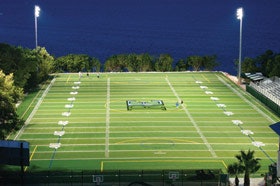
The extra resilience of a shock pad comes at a price: between $75,000 and $100,000, depending on the size of the field. However, shock pad proponents insist that the extra layer extends the life of the turf backing, sparing it direct contact with the crushed-stone drainage layer underneath. And because it is never exposed to direct sunlight or foot traffic, a single pad is likely to survive more than one complete loose-laid turf replacement. Buyers also have the option of taking crushed stone completely out of the system's cross-section, substituting it with a thinner polypropylene product that's both permeable and resilient, not to mention cost-effective in its elimination of the need to purchase and haul tons of stone.
Systems that lack any infill, and the nearly 250,000 pounds of ballast that comes with it, require not only a pad for resiliency, but also an adhesive product to keep the carpet firmly in place. Some end users of infill systems likewise favor a fully adhered field as the best means of eliminating the skewing of lines and the peeling and sheering of seams - even if those seams are already held together with glued seaming tape, stitching or a combination of the two.
Who do I tab to get the job done right? Once you have a clear idea of how you want a synthetic turf field to look and perform, it's common practice to consider the bids of three or four field builders. Mulling the project can - and likely will - take longer than the two months a builder needs to actually complete it. "Because of the cost of these projects, most buyers are spending a lot of time during the due diligence phase to understand what their options are," says Rick Doyle, president of the Synthetic Turf Council, a consortium of turf companies whose web site (www.syntheticturfcouncil.org) attracts 50,000 weekly visits from information-hungry consumers. "A big part of our mission is to assist the public - once they've made the decision to purchase synthetic turf - in understanding how to make that decision meet their specific needs."
Just as in your decision-making about field specifics, take care to weigh the merits of each potential partner. You may ultimately discover that one synthetic field on your athletics campus or sports complex isn't enough. "We're seeing growth in the industry of upwards of 20 percent a year," says a representative of one leading field builder. "It's really key that you make sure that you're looking at companies that have a history, that have a reference list and a background that you're comfortable with. While people think that purchasing a synthetic turf field is a one-time deal, you're really creating a partnership." A rival turf company's president puts it this way, "It's not about the wedding; it's about the marriage. There's a lot to administering these highly visible projects, and the company you partner with can make the difference between that project being the best thing that's ever happened for the community, or the worst."






















